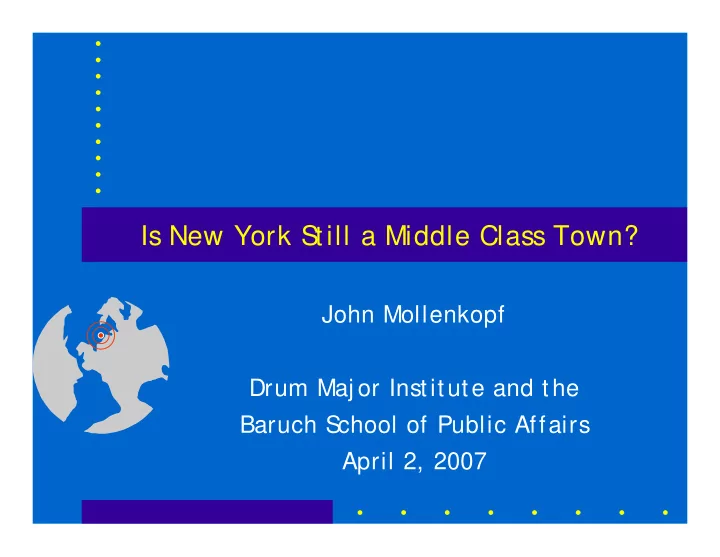

Is New York S till a Middle Class Town? John Mollenkopf Drum Maj or Institute and the Baruch S chool of Public Affairs April 2, 2007
The Paradox: Growing Inequality Amidst Overall Prosperity • A growing economy – Despite employment fluctuating around 3.5 million, real earnings have grown, driving up real estate prices, creating a housing construction boom, improving city’ s fiscal position • But income distribution is increasingly unequal – More people live in households at the bottom (below $30K) and top (above $250K), fewer in the households in between
Total Payroll Employment in New York City 1958 - 2006 3800 3800 3600 3600 3400 3400 3200 3200 3000 3000 2800 2800 1958 1960 1962 1964 1966 1968 1970 1972 1974 1976 1978 1980 1982 1984 1986 1988 1990 1992 1994 1996 1998 2000 2002 2004 2006 Source: New York State Department of Labor, Current Employment Statistics Survey, Annual Averages
Total Real Wages for Workers in New York City 1975 – 2006 In Trillions of Constant Dollars 1982-1984 = 100/ 2006 = 215.0 190 170 150 130 110 90 70 50 1975 1977 1979 1981 1983 1985 1987 1989 1991 1993 1995 1997 1999 2001 2003 2005 Source: NYS DOL ES202/QCEW Series SIC 1975-2000, NAICS 2001-2006
Average Real Annual Wage in New York City 1975 – 2006 2005 2003 2001 eptember 2005 = 215.8 1999 1997 1995 In Thousands of Constant Dollars 1982-1984 = 100/ S 1993 1991 1989 1987 1985 1983 1981 1979 1977 1975 40 35 30 25 20
1990 2005 1990 Changing Income Distribution 1990 – 2005 $500K+ $500K $450K $400K $350K $300K (Percent of People by Household Income, Constant $2005) $280K $270K $260K $250K $240K $230K $220K $210K $200K $190K $180K Source: 1990 Public Use Microdata Sample, 2005 ACS $170K $160K $150K $140K $130K $120K $110K $100K $90K $80K $70K $60K $50K $40K $30K $20K $10K $5K 12 11 10 9 8 7 6 5 4 3 2 1 0
Population by 1990 Income Quintiles 25 1990 20 2005 15 10 5 1990 0 Fifth Fourth Third S econd First
Total Earnings by 1990 Income Quintiles (Trillions of $2005) 120 1990 100 2005 80 60 40 20 1990 0 Fifth Fourth Third S econd First
The DMI Brackets 1990-2005 (S ingles = $45-90K, Families = $75-135K) 80 1990 60 2005 40 2005 20 1990 0 Low Middle High
Poverty Brackets 1990-2005 (Low = < 2 X Poverty, Middle = 2 to 5 X Poverty, High = > 5 X Poverty) 40 1990 30 2005 20 2005 10 1990 0 Low Middle High
Any Way You Look At It… • The number of people in the bottom and top parts of the income distribution are growing relative to those in the middle • The top part is growing relative to the others not only in numbers, but in total income • Average incomes are thus rising mainly because the top is pulling them up
Why Aren’ t People Feeling ‘ Relative Deprivation’ ? • Who occupies the brackets changes over time • The shrinking number of native white households is shifting markedly upwards • To a far less extent, this is also true of native black and Hispanic households • The growing number of immigrant white, black, and Asian households is fairly evenly distributed across brackets • But Immigrant Hispanic households are clustered at the bottom
Household Income by Race ( Native HH Head) (People in Households – Low = Under 2 X Poverty, high = Over 5 X Poverty) 1200000 Low in 90 1000000 Low in 05 800000 Middle in 90 600000 Middle in 05 High in 90 400000 High in 90 Middle in 90 High in 05 200000 Low in 90 0 Whites B A His lacks s ians panics Source: 1990 Public Use Microdata Sample, 2005 ACS
Household Income by Race ( Foreign HH Head) (People in Households – Low = Under 2 X Poverty, High = Over 5 X Poverty) 700000 Low in 90 600000 Low in 05 500000 Middle in 90 400000 Middle in 05 300000 High in 90 High in 90 200000 Middle in 90 High in 05 100000 Low in 90 0 Whites B A His lacks s ians panics S ource: 1990 Public Use Microdata S ample, 2005 ACS
Bottom Lines • Growing income inequality does not prevent many households from being upwardly mobile • Native households are diminishing part of overall population, especially at the low end • White, black, and Asian immigrant households are growing all across income distribution • But Hispanic immigrant households remain clustered at the bottom
Recommend
More recommend